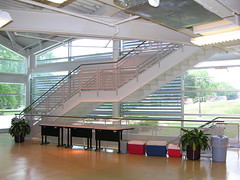Historically, humans have used engineering and technology to solve problems. But that's not good enough for our creative and beauty-loving nature. Even in ancient times, perfectly fine protective cave walls were covered with petroglyphs, and simple clay pots were adorned with intricate paintings.
We create functional designs that can evoke as much emotion as a fine painting. Use the following activities to explore the place where art and engineering meld.
language arts:
Be a Movie Star!
* Investigate movie making technology and how it's used by screen artists to create your favorite movies, http:// entertainment.howstuffworks. com/question295.htm and www. physorg.com/news/2011-02-hightech-moviemaking-video.html. Then make your own show! After you choose a topic, begin by creating a simple storyboard, designing the screen shots and building simple sets, then writing the script for your actors. Film your movie with video, podcast it, or create an animated version using some of these free online animation programs: http:]] goanimate.com/; www.fluxtime. com; and www.miniclip.com/sketchstar/en/ OR go all the way with real stop-animation videos and purchase an easy-to-use program called SAM animation: www.samanimation. com/.
* If you have access--try Windows Movie Maker or iMovie to edit your footage into a final product to share with all!
[ILLUSTRATION OMITTED]
math:
Discover the Secret Mathematics in Art with the Golden Ratio!
* Many artists proportion their works to approximate the Golden Ratio; and so does nature. The Golden Ratio is a special number that is equal to its own reciprocal plus one. The actual number is 1.618. Fibonacci, an Italian mathematician, linked the study of math, nature, and art by discovering an infinite sequence of numbers that could calculate a means to reach the Golden Ratio. The first two Fibonacci numbers are o and I, and each next number is the sum of the previous two: 0, 1,1, 2, 3, 5, 8,13, 21, 34, 55, 89,144 ... Not only is this sequence used in engineering, but it appears throughout nature, www.youtube. com]watch?v=AzfHbETDbN8&featur e=related
[ILLUSTRATION OMITTED]
[ILLUSTRATION OMITTED]
* Have your students go on a Fibonacci scavenger hunt in and out of school and share their findings. Then graph the results and create a class Fibonacci collage.
Science:
Engineer Art that Moves!
* Browse through these amazing kinetic sculpture sites to see art in action:
Artist Theo Jansen: www. youtube.com/watch?v=OR_-YellQo&feature=related Artist Reuben Margolin: http:// vimeo.com/3001833 Artist Lyman Whitaker: www.youtube.com/ watch?v=hpZvn3YtPYY Kid Art: www.youtube.com] watch?v=81f4nBhKgtE
* As you watch the sculpture videos, brainstorm what enables the art to move. Discuss levers and fulcrums, weight and balance, pulleys, gears, wheels, materials, potential and kinetic energy, and perpetual motion.
* Now, to design your own action art ... first choose your energy (wind, heat, water, electricity, people) and location (hanging in air, on ground, etc.). Next sketch your design. Then choose your building material (paper, junk, plastic... ). Finally build and test your art!
* Younger students can focus more on shape, weight, and balance by creating their own mobiles or modifying premade designs, www. enchantedlearning.com]crafts] mobiles]
[ILLUSTRATION OMITTED]
[ILLUSTRATION OMITTED]
Make Magical Magnetic Art
* Ferrofluid is a liquid solution that acts like a solid in the presence of a magnetic field. It is a technology that is currently used for seals in electronic devices, brakes in mechanics, aerospace control systems, heat transfer in loudspeakers, and MRI cancer detection. It is also quickly becoming its own bizarre art form! Check out this Ferrofluid sculpture: www. youtube.com/watch?v=eDnrFgd7yfo Then find out how Ferrofluid works: www.youtube.com] watch?v=PvtUto2zVAs.
* Now it's time to make your own magnetic magic. You can buy quality Ferrofluid for about $40, www.teachersource.com/ Electricity And Magnetism/Ferrofluid/ BulkFerrofluid.aspx, or you can make your own with MICR toner and vegetable oil. www.youtube.com/ watch?v=vsQh1AT6qUE (recipe)
* You will also need a clear container and Latex gloves for each student. Use Neodymium magnets (rareearth) for activating your art. Regular magnets aren't strong enough.
* Pour Ferrofluid, 1-2 inches deep, into your container. Petri dishes with lids work well. ***Caution!*** This is messy-staining stuff that will creep right out of the dish! Gluing the lids on AND then sealing with clear caulk worked for me. Keep the magnets on the dish bottom and sides, and be ready to be amazed!
Social Studies:
Create some cool!
* We all want our car to start every morning and get us safely to where we need to go. But, we also want our car to look good along the way! Automobile companies are acutely aware of our love affair with cars, so their designers work tirelessly to give us just what we want. Check out the latest in car design technology: www.cardesignonline.com/design/. And try the online design simulation at www.12playgamesonline.com/ Games/Create-Ride-Design-YourDream-Car-G367.html
[ILLUSTRATION OMITTED]
* Next have a "cool car" design challenge. All students or teams must start with the basic functions and parts of a vehicle. After that, their inner artist can take over. They can sketch on graph paper/ use "Google Sketch Up" (a simple online CAD program), make posters. Older students could even create Styrofoam or clay models of their designs and test them in a wind tunnel. As an extension, students can produce promo-live or video clips for their cool designs. Some fun promo examples: www.youtube. com/watch?v=tlcKySQvl_4 and www.youtube.com/watch?v=R55euHQnao.
* All activities can be modified according to grade level.
Krista Jones is a teacher of P-5 Engineering Technology Education at Bellevue Elementary School Bellevue, Idaho. She can be reached via email at kjones@blaineschools.org.
Jones, Krista
Source Citation
Jones, Krista. "Ideas for integrating technology education into everyday learning." Children's Technology and Engineering Sept. 2011: 21+. Psychology Collection. Web. 14 May 2012.
Document URL
http://go.galegroup.com/ps/i.do?id=GALE%7CA278276633&v=2.1&u=22054_acld&it=r&p=PPPC&sw=w
Gale Document Number: GALE|A278276633


No comments:
Post a Comment